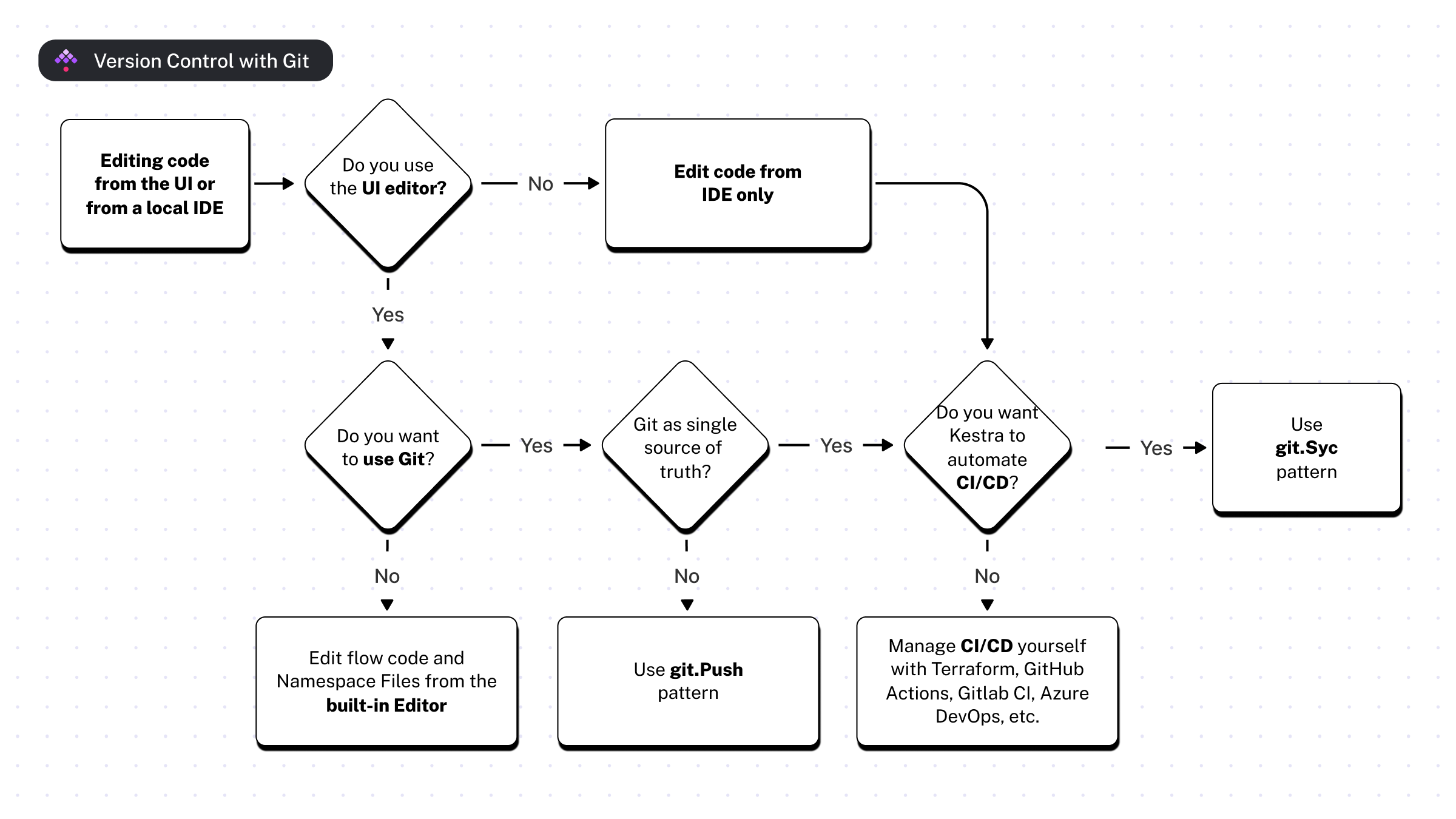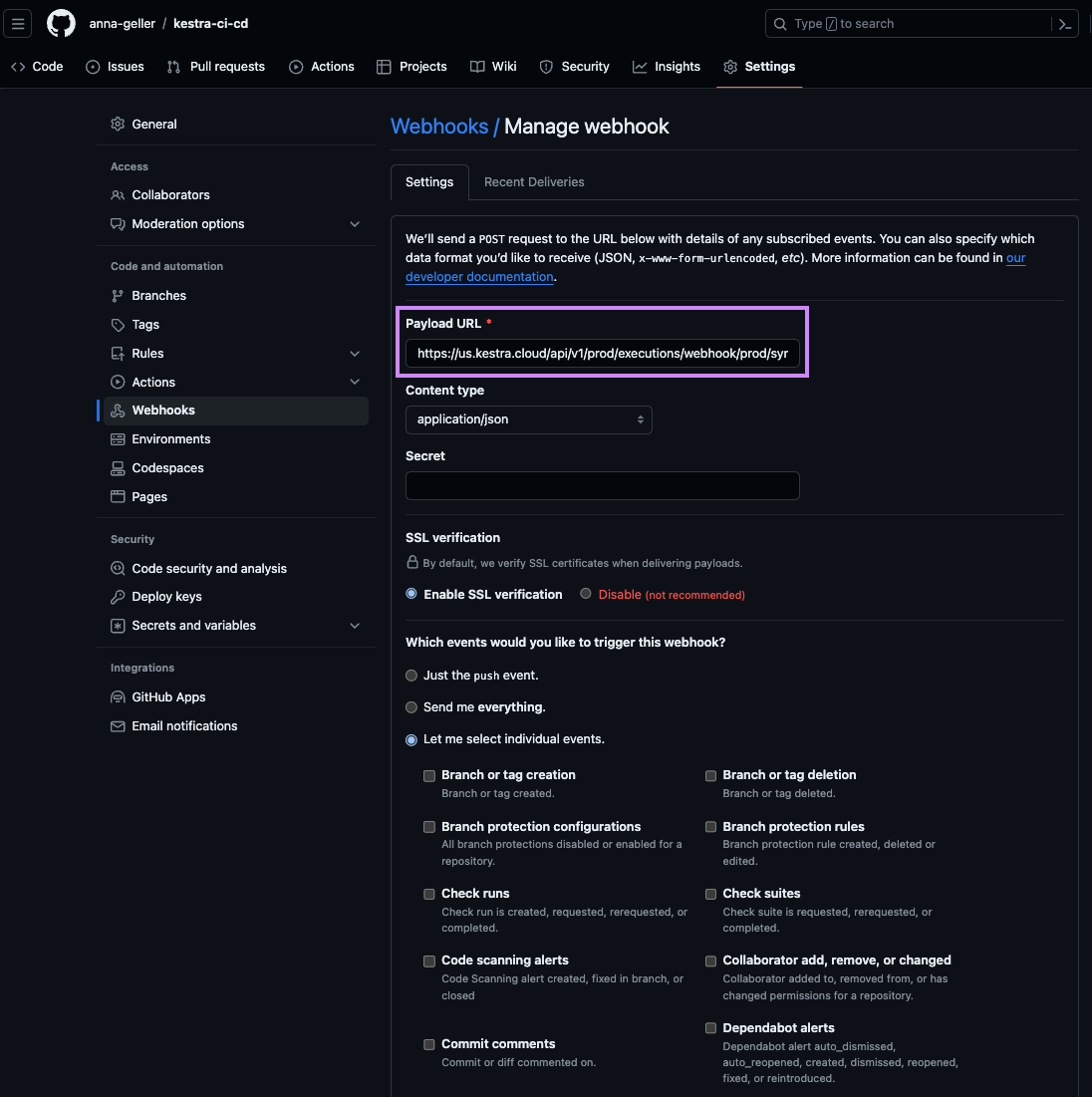 Version Control with Git
Version Control with Git
Learn how to pair Kestra with Git so you can version flows, namespace files, and related artifacts alongside your application code.
Kestra supports version control with Git. You can use one or more repositories to store your flows, namespace files, apps, tests, and dashboards, tracking changes through Git history.
There are multiple ways to combine Kestra with Git:
- SyncFlows implements GitOps with Git as the single source of truth for flows.
- SyncNamespaceFiles syncs namespace files the same way.
- PushFlows commits and pushes flow edits from the UI to Git, useful when you rely on the built-in editor but still want version history.
- PushNamespaceFiles does the same for namespace files.
- Clone clones a repository directly into a flow so scripts are available at runtime.
- TenantSync synchronizes all namespaces in a tenant, including flows, files, apps, tests, and dashboards.
- NamespaceSync keeps a single namespace in sync with a Git repo.
- A custom CI/CD pipeline lets you manage deployments yourself (GitHub Actions, Terraform, etc.) while keeping Git authoritative.
The image below shows how to choose the right pattern based on your needs:

Let's dive into each of these patterns and when to use them.
Git SyncFlows and SyncNamespaceFiles
The Git SyncFlows pattern implements GitOps with Git as the single source of truth. Store flows in Git, and run a system flow that automatically syncs changes into Kestra. The Git SyncNamespaceFiles pattern mirrors this for namespace files.
Here's how it works:
- Store flows and namespace files in Git.
- Schedule a system flow that syncs changes from Git to Kestra.
- Modify files in Git whenever you need to change a flow or namespace file.
- The system flow syncs those changes, overwriting any conflicting UI edits with the Git version.
This pattern suits teams that treat Git as the single source of truth and prefer not to edit flows or namespace files in the UI. No CI/CD pipeline is required, so it's ideal if you already follow GitOps practices or come from a Kubernetes background.
Here is an example system flow that you can use to declaratively sync changes from Git to Kestra:
id: sync_from_git
namespace: system
tasks:
- id: git
type: io.kestra.plugin.git.SyncFlows
url: https://github.com/kestra/scripts
branch: main
username: git_username
password: "{{ secret('GITHUB_ACCESS_TOKEN') }}"
targetNamespace: git
includeChildNamespaces: true # optional; by default, it's set to false to allow explicit definition
gitDirectory: your_git_dir
triggers:
- id: schedule
type: io.kestra.plugin.core.trigger.Schedule
cron: "*/1 * * * *" # every minute
Commit this flow to Git or add it via the built-in editor; it won't be overwritten by reconciliation.
You can also sync namespace files with the example below:
id: sync_from_git
namespace: system
tasks:
- id: git
type: io.kestra.plugin.git.SyncNamespaceFiles
namespace: prod
gitDirectory: _files # optional; set to _files by default
url: https://github.com/kestra-io/flows
branch: main
username: git_username
password: "{{ secret('GITHUB_ACCESS_TOKEN') }}"
You can also trigger this flow with a GitHub webhook whenever changes land in Git:
id: sync_from_git
namespace: system
tasks:
- id: git
type: io.kestra.plugin.git.SyncFlows
url: https://github.com/kestra/scripts
branch: main
targetNamespace: git
username: git_username
password: "{{ secret('GITHUB_ACCESS_TOKEN') }}"
triggers:
- id: github_webhook
type: io.kestra.plugin.core.trigger.Webhook
key: "{{ secret('WEBHOOK_KEY') }}"
The webhook key authenticates requests and prevents unauthorized access. For the flow above, paste the following URL into your repository’s Webhooks settings:
http://your_kestra_host:8080/api/v1/<your_tenant>/executions/webhook/prod/sync_from_git/your_secret_key

Following the pattern:
http://<host>/api/v1/<tenant>/executions/webhook/<namespace>/<flow>/<webhook_key>
CI/CD
The CI/CD pattern still treats Git as the single source of truth but pushes code changes to Kestra whenever a pull request merges. Unlike the Sync pattern, you manage the automation (GitHub Actions, Terraform, etc.). See the CI/CD docs for setup details.
Git PushFlows and PushNamespaceFiles
The Git PushFlows pattern lets you edit flows in the UI while pushing versions to Git. The Git PushNamespaceFiles pattern offers the same workflow for namespace files.
Example flow for pushing from Kestra to Git:
id: push_to_git
namespace: system
tasks:
- id: commit_and_push
type: io.kestra.plugin.git.PushFlows
url: https://github.com/kestra-io/scripts
sourceNamespace: dev
targetNamespace: pod
flows: "*"
branch: kestra
username: github_username
password: "{{ secret('GITHUB_ACCESS_TOKEN') }}"
commitMessage: add namespace files changes
triggers:
- id: schedule
type: io.kestra.plugin.core.trigger.Schedule
cron: "* */1 * * *" # every hour
Example flow for pushing namespace files:
id: push_to_git
namespace: system
tasks:
- id: commit_and_push
type: io.kestra.plugin.git.PushNamespaceFiles
namespace: dev
files: "*"
gitDirectory: _files
url: https://github.com/kestra-io/scripts # required string
username: git_username
password: "{{ secret('GITHUB_ACCESS_TOKEN') }}"
branch: dev
commitMessage: "add namespace files"
triggers:
- id: schedule_push_to_git
type: io.kestra.plugin.core.trigger.Schedule
cron: "*/15 * * * *"
Use this pattern to push to a feature branch and open a pull request for review.
Git Clone
The Git Clone pattern clones a repository at runtime so you can orchestrate code managed elsewhere, for example:
- dbt projects via the dbt CLI task
- Infrastructure deployments via Terraform CLI or Ansible CLI
- Docker builds via the Docker Build task
Git TenantSync and NamespaceSync
Both Git TenantSync and Git NamespaceSync give you full control over synchronizing Kestra objects with your Git repository.
TenantSync– synchronizes all namespaces in a tenant, including flows, files, apps, tests, and dashboards.- Requires
kestraUrlandauthso the task can validate tenant-wide RBAC. - Useful when you need to back up the entire tenant to Git and promote environments through pull requests.
- Requires
NamespaceSync– synchronizes objects within a single namespace with your Git repository.- Requires the
namespaceproperty but notkestraUrlorauth; it relies on namespace-level RBAC and can be run by any user with sufficient permissions. - Ideal for teams that sync one namespace per repository, allowing owners to manage their own syncs.
- Requires the
Both plugins support:
sourceOfTruth(GITorKESTRA) to define the update strategy.whenMissingInSourcewith optionsDELETE,KEEP, orFAILto control how missing objects should be handled.- An opinionated folder structure for flows, apps, dashboards, tests, and files with one folder per namespace.
protectedNamespacesto ensure your Kestra objects from critical namespaces (such assystem) are not accidentally deleted whensourceOfTruthisGIT.- Validation rules requiring explicit Git
branchand optionalgitDirectory. - Options like
dryRunandonInvalidSyntaxfor safe rollouts and error handling.
Example usage of the TenantSync task:
id: tenant_git_sync
namespace: system
tasks:
- id: tenant
type: io.kestra.plugin.git.TenantSync
sourceOfTruth: KESTRA
whenMissingInSource: DELETE
url: https://github.com/org/repo
branch: main
protectedNamespaces:
- system
kestraUrl: http://localhost:8080
auth:
username: [email protected]
password: "{{ secret('KESTRA_PASSWORD') }}"
Example usage of the NamespaceSync task:
id: namespace_git_sync
namespace: system
tasks:
- id: namespace
type: io.kestra.plugin.git.NamespaceSync
namespace: company.team
sourceOfTruth: GIT
whenMissingInSource: KEEP
url: https://github.com/org/repo
branch: main
protectedNamespaces:
- system
Was this page helpful?